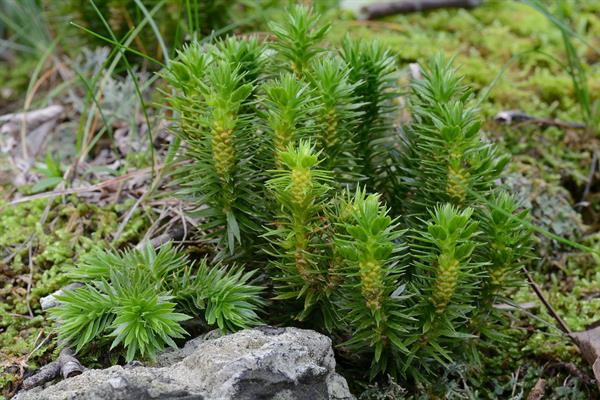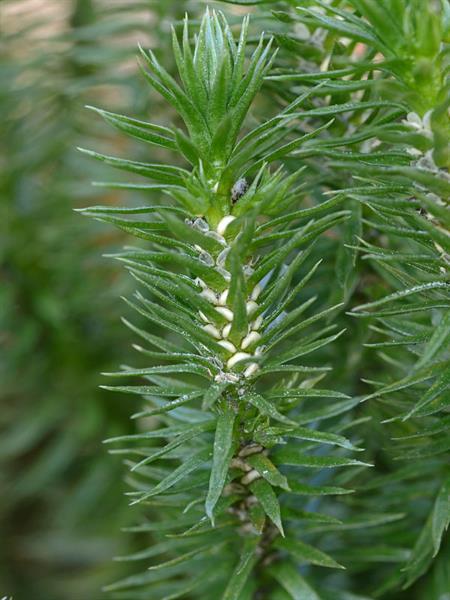
A genus of about 10-15 (or with an additional 15 or more undescribed) species, north temperate and arctic (and tropical mountains of Asia).
ID notes:The genus Huperzia is recognized by its stiff, upright stems borne in a cluster, the stems usually 2-20 cm tall, with many spreading to ascending leaves 2-11 mm long and the larger leaves > 5× as long as wide and with acute tips, with yellow sporangia in the leaf axils near the top of the stem, and by the usual presence of 3-lobed gemmae (vegetative propagules) also borne in leaf axils. In the Flora region, Huperzia is nearly restricted to the inland provinces, found in the Coastal Plain only from NC northwards. Most species are associated with rock outcrops, except Huperzia lucidula which typically occurs in moist soils of forests.
Key advice:Several hybrids are known from our area; they usually occur in intermediate habitats (such as in thin soil at the base of cliffs) and generally are found in proximity to both parents, but sometimes occur in the absence of one or both parents. Hybrids can be recognized by their intermediate morphology (and are not keyed).
Ref: Björk (2020); Haines (2003a); Øllgaard In Kramer & Green (1990); Testo, Haines, & Gilman (2016); Wagner & Beitel (1993) In Flora of North America Editorial Committee (1993b); Wikström & Kenrick (2000); Zhang & Iwatsuki in FoC (2013). Show full citations.
Hover over a shape, letter, icon, or arrow on the map for definition or see the legend. Data for arrows not developed for genera and families which may have species only occurring outside the flora area.
 © Gary P. Fleming | Huperzia appressa | Original Image ⭷
© Gary P. Fleming | Huperzia appressa | Original Image ⭷ © Alan M. Cressler | Huperzia porophila | Original Image ⭷
© Alan M. Cressler | Huperzia porophila | Original Image ⭷ © Alan Cressler: Huperzia porophila, Yellow Birch Ravines Nature Preserve, Crawford County, Indiana 7 by Alan Cressler | Huperzia porophila source | Original Image ⭷
© Alan Cressler: Huperzia porophila, Yellow Birch Ravines Nature Preserve, Crawford County, Indiana 7 by Alan Cressler | Huperzia porophila source | Original Image ⭷ © Gary P. Fleming | Huperzia appressa | Original Image ⭷
© Gary P. Fleming | Huperzia appressa | Original Image ⭷ © Edwin Bridges | Huperzia lucidula | Original Image ⭷
© Edwin Bridges | Huperzia lucidula | Original Image ⭷ © Alan Cressler: Huperzia porophila, Yellow Birch Ravines Nature Preserve, Crawford County, Indiana 1 by Alan Cressler | Huperzia porophila source | Original Image ⭷
© Alan Cressler: Huperzia porophila, Yellow Birch Ravines Nature Preserve, Crawford County, Indiana 1 by Alan Cressler | Huperzia porophila source | Original Image ⭷Feedback
See something wrong or missing on about Huperzia? Let us know here: (Please include your name and email if at all complicated so we can clarify if needed.)
Cite as...